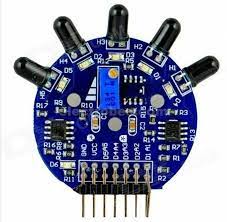
5 Channel Flame Sensor Module
Description:
The Flame Sensor Module with Analog Output is an electronic device designed to detect the presence of flames or fire in its vicinity. It is commonly used in fire detection systems, safety equipment, and flame monitoring applications.
The module typically consists of a flame sensor, a signal processing circuit, and an analog output interface. The flame sensor is usually based on a photodiode or a phototransistor, which is sensitive to the infrared (IR) radiation emitted by flames.
When a flame is detected, the sensor receives the IR radiation emitted by the flame and generates an electrical signal proportional to the intensity of the detected radiation. The signal processing circuit then processes the analog signal and provides an output that can be read by a microcontroller or other digital devices.
The output of the flame sensor module is typically in analog form, meaning it provides a continuous voltage or current proportional to the detected flame intensity. The analog output can be used to determine the level of flame present, allowing for further actions to be taken, such as activating an alarm or triggering a safety mechanism.
The sensitivity of the flame sensor module can usually be adjusted using a potentiometer or jumper settings on the module itself. This allows for customization and optimization of the detection threshold based on the specific application requirements.
It's important to note that the analog output from the flame sensor module requires additional analog-to-digital conversion if digital processing or interfacing is desired. This can be done using an analog-to-digital converter (ADC) on a microcontroller or a separate ADC module.
The flame sensor module with analog output provides a convenient and reliable method for detecting the presence of flames and can be integrated into various fire safety and monitoring systems. It offers flexibility in signal processing and compatibility with different microcontrollers or digital devices for further analysis and actions based on the detected flame intensity.
Specifications:
- Sensitivity: The sensitivity of the flame sensor module can often be adjusted using a potentiometer or jumper settings to customize the detection threshold.
- Analog Output: The module provides an analog output that is proportional to the intensity of the detected flame. The specific output range and format (voltage or current) can vary. For example, the analog output may range from 0V to a certain maximum voltage or from 0mA to a specific maximum current.
- Detection Range: The detection range refers to the distance from which the flame sensor can reliably detect flames. This range can vary depending on factors such as the size of the flame and ambient conditions.
- Response Time: The response time of the flame sensor module indicates how quickly it can detect the presence of a flame and provide an output signal.
- Operating Voltage: The operating voltage range within which the flame sensor module functions properly. It can typically range from a few volts to several volts, depending on the module.
- Dimensions: The physical dimensions of the module, which can vary depending on the manufacturer or model.
- Mounting: The module may have mounting holes or other mechanisms to facilitate easy installation and integration into a system.
